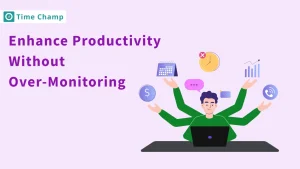Hey do you want to increase employee productivity in the workplace and are unable to achieve that, let me tell you a story.
Once upon a time, a chocolate company faced a significant dilemma. The prices of materials for chocolate-making had increased, but they couldn’t raise the cost of their chocolate because the buyers were comfortable with the old price. To resolve this, the chocolate company came up with an idea: instead of increasing the price, they reduced the quantity of chocolate in each package. This strategy helped them maintain profitability.
Just as the chocolate company faces rising costs, managers often need to maintain employee productivity without increasing pressure on their team.
But here’s the burning question:
Why is Employee Productivity Important in the Workplace?
Let us discuss, why employee productivity is important and why you need to concentrate on it more.

- Increased Profitability and Growth: Increased profitability and growth are directly influenced by employee productivity. When employees accomplish work tasks efficiently, it enhances the overall efficiency of the firm. This improved efficiency leads to better organizational performance, which translates into business growth or expansion.
- Cost Reduction: Productive employees help in reducing the operational costs of an organization with an effective elimination of overtime costs as well as minimizing resource wastage. The cost-effectiveness increases the firm’s strength and vitality financially.
- Optimized Resource Allocation: Increased productivity helps to ensure resources such as time, skills, and finances are utilized efficiently. This optimization leads to cost savings, improved project management, and the ability to allocate resources to critical areas, boosting overall organizational performance.
- Improved Innovation and Problem-Solving: Productivity results in better time utilization, allowing employees to focus on innovation and problem-solving. This fosters a culture of enhanced effort and drives business advancement.
These are the main things that make employee productivity more important in the workplace. Do you know what are the factors that affect your employee productivity?
What Affects Employee Productivity?
There are so many factors that are affecting employee productivity, so let’s discuss some of them

- Work Environment: The work environment really matters when it comes to employee productivity. Factors like office layout, noise levels, lighting, and overall vibe can make a big difference. A positive, well-designed workspace can boost focus and motivation, while a poor setup can drag down performance.
- Workload Management: Workload management thus helps to ensure that the right attention is allocated to the right task and that time is spent conscientiously and productively to meet deadlines. Neglecting the workload management can lead to time and energy waste, causing more stress and poor results on the quality of the work.
- Technology and Resources: Technology and resources play a crucial role in employee productivity. For example, using outdated technology or the absence of appropriate software at work can result in time loss and make it difficult to work.
- Employee Well-being: Workforce health is crucial to workplace productivity. If the employee is healthy then he can contribute more and else less. It is important to help employees achieve well-being for vital workflow.
Now that we know what affects productivity, let’s dive into some practical methods to boost it in your workplace.
Methods to Increase Employee Productivity in the Workplace

1. Setting SMART Goals:
A SMART goal is a strategy of identifying proper and effective goals, that are specific, measurable, attainable, relevant, and timely. It helps in increasing employee productivity.- Specific: To make sure that should specify and clearly define what is expected of the goal. Identifying the responsible party, and outlining the necessary steps for attainment. The goal can become clearly defined by addressing these aspects and providing precise direction for stakeholders.
- Measurable: Define the key performance indicators to demonstrate the progress towards the goal. What is the criterion for determining when the objective is achieved. Quantifiable objectives are helpful as they provide a means to measure progress and assess success and thus keep individuals focused.
- Achievable: Goals should need to be realistic with the organization in terms of the skills that they have, the material resources available to them and their workloads. Too high goals will cause demotivation and decrease productivity while easy-to-reach goals and increase productivity.
- Relevant: It needs to be compatible with the individual’s skills and capabilities, as well as with the goals and objectives of the organization. Such goals are important and valuable and directly impact individual, team, and organizational performance.
- Time-bound: Define the time in which the goal is to be achieved. This makes employees aware of time, concentrate fully and especially, and avoid delaying tasks until the very last.
2. Motivation Matters: Fostering a Culture of Engagement
Employees who feel valued and motivated are more likely to go the extra mile, which increases employee productivity. Here’s how to create that environment.- Recognize and Reward Achievements: Recognition is important for employees for their work. General praise and appreciation rewards not only inspire and motivate workers but also help, create desirable behaviour and enhance workers’ performance to a higher level of excellence.
- Provide Growth Opportunities: Providing opportunities to employees enhances their knowledge and abilities. It contributes to their actual professional growth and helps to maintain their interest and engagement. If the employees are confident that their career and personal development lie within the organization. It becomes easy for them to work harder and thus become more productive in the organization.
- Promote Purpose and Meaning: When employees see how their work directly contributes to the success of the organization, it can really make a difference. If they understand that what they’re doing is important and see the positive impact their efforts have on the business, it gives their work a sense of purpose. This, in turn, boosts their motivation to work harder.
- Performance Improvement: When employees get constructive feedback on their work, they understand places where they are weak at the workplace. This understanding helps them grow and ultimately boosts the overall performance of the organization.
- Skill Development: Feedback gives recommendations on skill improvement or other areas that need development. Therefore employee change the way they do it by acquiring new skills, which leads to improvement in their work and thus enhances their performance and productivity.
- Engagement: Giving frequent praise about the good work done by an employee is a key part of feedback that can really boost an employee’s motivation, they feel valued and are driven to work even harder. This increased motivation leads to higher productivity and better overall outcomes.
4. Empowerment Over Micromanagement: Trust and Autonomy
Micromanagement stifles creativity and initiative. Here’s how to empower your employees:- Increased Ownership: When employees are assigned responsibilities that align with their abilities and are empowered to determine how to accomplish the tasks given to them, it develops a sense of ownership. This ownership encourages them to be active, take initiative, and become excellent workers and increases their productivity.
- Efficient Problem-Solving: Delegating responsibility for solving problems to employees instead of micromanaging them fosters critical thinking and decision-making abilities. Employees empower employees to identify and resolve problems on their own resulting in faster problem-solving and greater efficiency.
- Time Management and Focus: By defining boundaries and expectations while giving them control over their time and working style, you empower them to make time management decisions themselves. This implies that the employees are left to work on their own without any disturbances. Trusting them in this way boosts their efficiency and output.
5. Assigning Realistic Tasks: Setting Employees Up for Success
Don’t set your employees up for failure. Consider these points:- Skills and Experience: Workers need to have the competencies and knowledge for the job. It provides them with adequate training and support so that they can be able to execute their work better and increase their productivity levels.
- Workload Management: Working people to exhaustion causes work fatigue and inefficiency in the workforce. Managers can also help employees manage their time better by coming up with a to-do list and setting reasonable timeframes for each task to be completed to achieve the desired outcomes.
- Resource Availability: Tools and resources which are needed for the task completion are fundamental. Providing employees with the resources they need at the right time eliminates delays and saves time.
6. Promoting Work-Life Balance:
Employees who are burnt out are unlikely to be productive. Here’s how to support a healthy work-life balance:- Preventing Burnout: Promoting employees to take days off and to have flexible working hours also prevents exhaustion of the employees and makes them more engaged and enthusiastic about the work enhancing their productivity.
- Enhancing Well-being: Asking for permissions and promoting work-life balance positively affects people’s health and their job performance. Motivated and productive employees are happy and healthy employees.
- Boosting Morale and Motivation: Employees who feel supported in their personal lives are more motivated and committed to their work than those who feel unsupported. This positive morale makes employees work harder and with increased efficiency.
7. Training and Development
A skilled and knowledgeable workforce is a productive workforce. Here’s why training matters:- Bridging Skill Gaps: Knowledge and skill gaps can be avoided through targeted training programs where employees can acquire new knowledge or skills to improve their performance and productivity.
- Upskilling and Reskilling: Providing courses in emerging technologies, procedures, or standards empowers workers to update their knowledge about the industry. This helps in maintaining their skills and efficiency at work hence promoting productivity.
- Enhanced Problem-Solving: Continuous training makes the employees capable of solving the problem on their own. This helps them to deal with challenges in more efficient ways. It results in more efficient workflows and productivity.
8. Reducing Distractions:
Removing distracting factors is one of the most effective ways to increase employee productivity. Reducing distractions involves- Manage Notifications: Employees should be advised to turn off the notifications on social media and vibrations on phones whenever they are engaged in specific work hours. It ensures that the employees can avoid digital distractions and can concentrate on the workday to do the work.
- Dedicated Workspaces: To reduce distractions from the surrounding environment, generate quiet zones or listeners noise-cancelling headphones. It is crucial to remember that working in open office space is distracting; therefore, employers must ensure that the work environment is as comfortable as possible for employees.
9. Utilizing Productivity Tracking Software
Utilizing productivity software can help to increase employee productivity. Software is critically needed for today’s business organizations looking for efficiency, better workflow, and increased productivity.That’s where Time Champ comes in:
Utilizing productivity employee tracking software like Time Champ has emerged as an effective strategy to enhance employee productivity across various industries. It provides employers and managers with insights into how time is spent during work hours, enabling them to identify patterns, measure productivity, and address inefficiencies.
Time Champ stands out as the best productivity management software, offering comprehensive tools to boost efficiency and streamline workflow. Its user-friendly dashboard gives a clear overview of the productivity metrics. Features such as automatic time tracking help to minimize the manual logging of hours, thus reducing administrative overhead. Additionally, the software can analyze the usage of applications and websites, determining whether employees are spending work hours on productive tasks.
Furthermore, Time Champ offers detailed productivity reports, which can lead to better time management strategies and informed decision-making. With this data, managers can set realistic goals, provide targeted feedback, and offer support where needed to help employees stay on track.
By implementing Time Champ, organizations harness the technology to promote a culture of productivity and accountability. This contributes significantly to improving overall organizational efficiency and performance. For more intricate details on how Time Champ can help in ramping up productivity levels, interested readers can visit the Time Champ.
Boost your team's efficiency effortlessly with Time Champ.
Join now and witness the growth.
Sign up for FreeBook DemoConclusion
Employee productivity is crucial for organizational success. By implementing these strategies and tailoring them to your specific workplace culture, you can create an environment that fosters a productive and engaged workforce, ultimately contributing to the overall success of your business.






